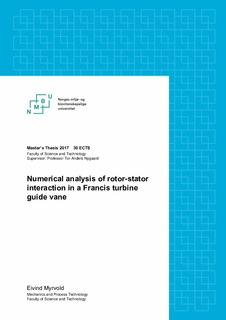| dc.contributor.advisor | Nygaard, Tor Anders | |
| dc.contributor.author | Myrvold, Eivind | |
| dc.date.accessioned | 2018-06-05T06:59:39Z | |
| dc.date.available | 2018-06-05T06:59:39Z | |
| dc.date.issued | 2017 | |
| dc.identifier.uri | http://hdl.handle.net/11250/2500241 | |
| dc.description.abstract | Rotor-stator interaction in high-head Francis turbines has led to several failures in recent years. Increasing efficiency demands require design optimization of the turbine components, which may lead to thinner profiles. Not only can the components withstand lower loads; quite often one or more of their natural frequencies are close to that of rotor-stator interaction. Most of the research available has been on runners, while other parts of the turbine are less studied. The main goal of this project was to investigate rotor-stator interaction in a Francis turbine guide vane in order to evaluate why resonance has not been a problem in this part of the turbine.
The finite element method was used for the structural analyses in this thesis. Modal analyses in air and water were conducted to evaluate the mode shapes and natural frequencies of the guide vane. As expected, a torsional mode showed a natural frequency close to the blade passing frequency. The distance to resonance in air was 4.7%. The natural frequency of the same mode in water was found to be 155.7 Hz as the added mass effect led to an 11% reduction. The distance to resonance in water was 6.5%.
A harmonic response analysis was performed by applying a pressure field on the guide vane blade. The results showed that the torsional mode was excited, and the resulting displacement amplitude was 0.14 mm on the guide vane leading edge. The rotor-stator interaction caused a torque of 4 616 Nm acting on the guide vane. Comparison was made with the friction moment caused by friction in the bearings. The bearings above and below the blade caused a combined friction moment of 5 150 Nm, indicating that the guide vane does not slide in the bearings. A modal analysis modelling the guide vane as fixed in these bearings showed that the natural frequency of the mode was no longer close to resonance. This is believed to be the reason why resonance problems have not been experienced for the guide vanes.
Damping calculations were performed using CFX. The goal was to evaluate the influence of damping if the torque does indeed overcome friction. The guide vane profile was forced to vibrate in the mode shape and frequency found for the first mode of the modal analysis in air. The displacement amplitude was set to 0.14 mm according to the results of the harmonic response analysis. Two methods of calculating the damping were used: one is the pre-defined aerodynamic damping option, while the other makes use of the wall work density on the blade. The calculated damping was found to be around 3-3.5% depending on the mesh and method of calculation. | nb_NO |
| dc.description.abstract | Flere høytrykks Francisturbiner har hatt problemer forbundet med rotor-stator interaksjon de siste årene. Et stadig press på å forbedre effektiviteten i slike turbiner medfører tynnere profiler og dermed strukturer som tåler mindre belastning. I tillegg observeres det at egenfrekvensen til turbinene ofte korrelerer med lastfrekvenser forbundet med rotor-stator interaksjon. Mye av forskningen på området er gjort på selve løpehjulene, mens færre studier er gjort av andre turbindeler. Hovedmålet i dette prosjektet har vært å undersøke rotor-stator interaksjon i ledeskovlene i en høytrykks Francisturbin. De strukturelle beregningene i oppgaven er gjort ved bruk av elementmetoden. Det ble gjennomført modalanalyser i luft og vann for å finne formen og egenfrekvensen til de ulike svingemodene. Som forventet var egenfrekvensen til en torsjonsmode nær frekvensen løpehjulsskovlene passerer ledeskovlene med. I luft ble avstanden til resonans beregnet til 4.7%. For beregningene i vann bidro effekten av «added mass» til å senke denne egenfrekvensen til 155.7 Hz, en 11% reduksjon. Avstanden til resonans i denne beregningen var 6.5%. | nb_NO |
| dc.language.iso | eng | nb_NO |
| dc.publisher | Norwegian University of Life Sciences, Ås | nb_NO |
| dc.rights | Attribution-NonCommercial-NoDerivatives 4.0 Internasjonal | * |
| dc.rights.uri | http://creativecommons.org/licenses/by-nc-nd/4.0/deed.no | * |
| dc.subject | Rotor-Stator interaction | nb_NO |
| dc.subject | Fluid-Structure interaction | nb_NO |
| dc.subject | Numerical analysis | nb_NO |
| dc.subject | Hydropower | nb_NO |
| dc.subject | Resonance | nb_NO |
| dc.subject | Francis turbines | nb_NO |
| dc.title | Numerical analysis of rotor-stator interaction in a Francis turbine guide vane | nb_NO |
| dc.type | Master thesis | nb_NO |
| dc.description.version | submittedVersion | nb_NO |
| dc.subject.nsi | VDP::Teknologi: 500 | nb_NO |
| dc.subject.nsi | VDP::Teknologi: 500::Maskinfag: 570 | nb_NO |
| dc.subject.nsi | VDP::Teknologi: 500::Maskinfag: 570::Mekaniske og strømningstekniske fag: 574 | nb_NO |
| dc.source.pagenumber | 74 | nb_NO |
| dc.description.localcode | M-MPP | nb_NO |

